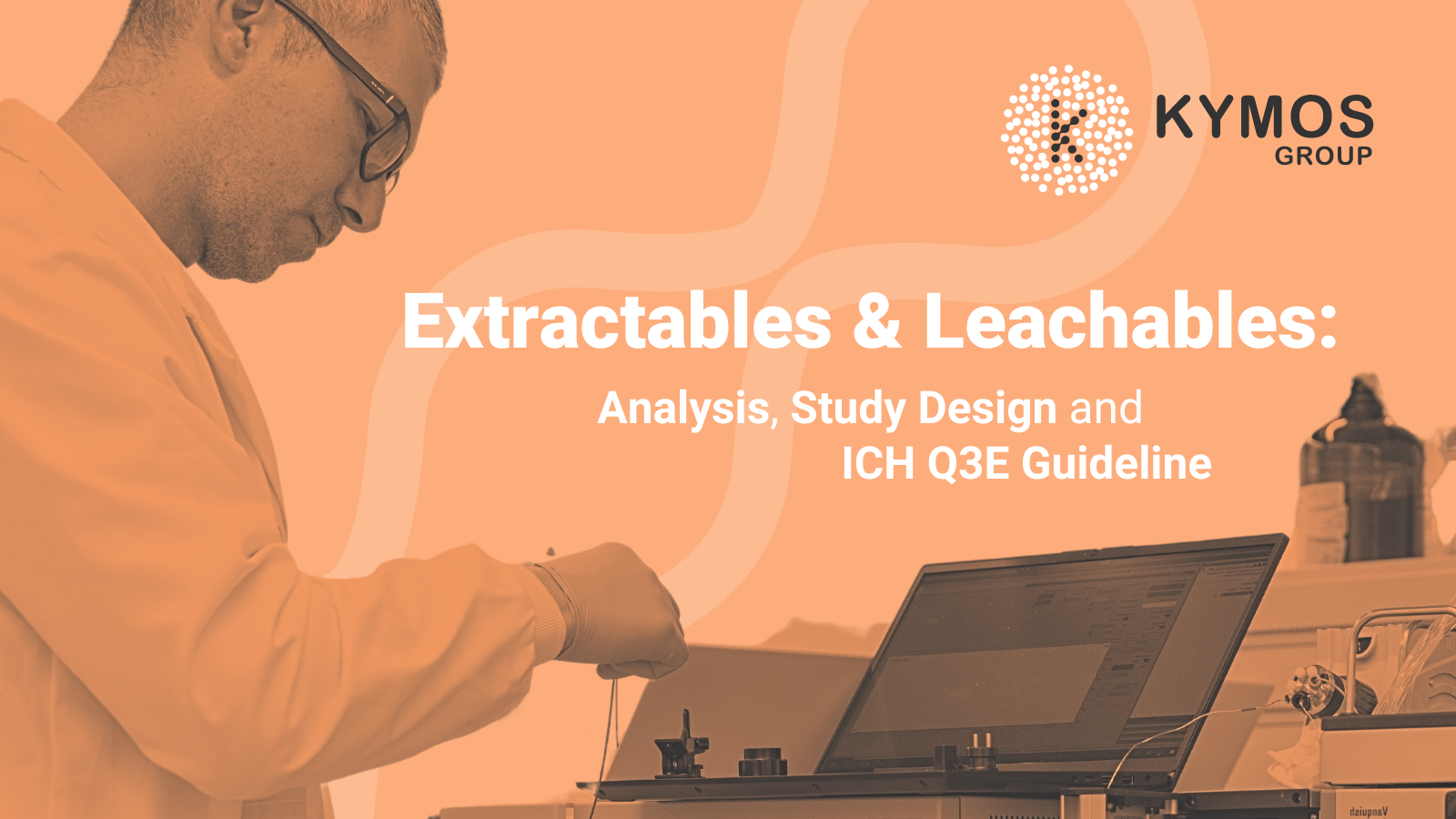
When developing and releasing pharmaceutical products to the market, ensuring their safety and efficacy is of critical importance. Determining the impurity profile is a must, and a vital part of it is the analysis and assessment of the extractables and leachables (E&L) resulting from the interaction of the pharmaceutical products and the packaging (container-closure systems, CSS), manufacturing components, and drug delivery systems.
In this article, we explore what extractables and leachables are and their differences, how do we perform E&L studies at Kymos, and an overview of its current regulatory situation and the future ICH Q3E planned for 2024-2025.
What are Extractables and Leachables?
As introduced before, extractables and leachables are both impurities produced from the chemical interactions of the final product and the previously mentioned involved parts, but they have key differences between them.
Extractables are organic or inorganic chemical species that can be “extracted” from packaging materials, manufacturing components, or drug delivery systems using laboratory-stressing conditions like strong solvents, accelerated or exaggerated temperatures, or surface exposure. These conditions simulate the worst-case scenarios, and the substances are characterized, identified and their safety and toxicology profile evaluated.
Leachables, on the other hand, are organic or inorganic chemical species that “leach” or are released under normal storage conditions during the normal lifespan of the pharmaceutical product. These leachables can affect human health and drug efficacy, and safety limits must be monitored. While extractables represent potential risks, leachables are the actual contaminants that patients may be exposed to during the product’s lifecycle.
Designing an E&L Study
Given the complex processes involved in the production of modern pharmaceutical products and the large number of potential leachables, designing an E&L study involves a comprehensive and structured process that is essential to ensure patient safety and efficacy of the drug product.
These studies comprehend two main distinct parts (extractables and leachables) that are related and linked. The extractables study identifies the impurities that could affect the pharmaceutical product and establishes the base on which the leachables study will be conducted.
The extractables part of the E&L study is conducted with each component of the primary packaging individually, performing the extraction with adequate solvents. Depending on the type of storage system the number of components to analyze will vary, and there’s also the need to consider the secondary and tertiary packaging. At Kymos Group we perform the extraction by techniques such as Reflux, Soxhlet, or Sonication, and we handle the samples with different solvents. We also perform simulation studies, in which fresh and expired samples of the finished pharmaceutical product are compared, in order to determine if the product itself has acted as solvent. The sample is then analyzed using specific techniques based on the type of compound: volatile, semi-volatile, or non-volatile.
- Semi-quantitative screening for both volatile and semi-volatile organic compounds:
- GC/MS instrumentation with direct injection sample introduction and electron impact ionization
- GC/MS instrumentation with headspace sample introduction and electron impact ionization
- NIST database to assist in the identification
- Semi-quantitative screening for non-volatile organic compounds:
- LC/HRMS Orbitrap detector, HPLC/UPLC MS (electrospray and atmospheric pressure chemical ionization), and LC/UV-vis
- Specific compound workflow identification by means of LC-HRMS analysis and Compound Discoverer software
- Semi-quantitative screening for inorganic/elemental compounds:
- ICP-MS instrumentation with high-capacity autosamplers
After the extractables study has been completed, the risk assessment and the toxicological evaluation are performed. These studies determine the potentially dangerous compounds that could be leached into the final product and their specification limit. In the leachables phase, the samples are analyzed for the detection of those compounds that were identified in the previous extractables study, and risk and toxicological assessment as potentially dangerous (we develop and validate methods for them). We can also perform untargeted screening analyses for unexpected leachables that may be generated since this type of non-targeted studies are becoming more important, especially for parenteral and ophthalmic dosage forms.
This last type of analysis is performed by identical screening methods as the ones conducted for extractables, and the principal benefit is that there’s no method development and no leachables will be missed as we will be screening for any potential leachable. Kymos Group is able to adapt to the risk profile of the pharmaceutical product and supports the client in choosing a targeted or non-targeted leachables strategy.
Future of E&L Analysis: ICH Q3E Guideline
Even though E&L studies are performed and required in pharmaceutical products, there is currently no ICH guideline specific to extractables and leachables. While there are guidelines addressing other relevant impurities (ICH M7, ICH Q3C, and ICH Q3D), there is a need for a harmonized document focused on E&L testing, risk assessments, and safety-based limits.
To answer this lack of a structured framework, the ICH committee of experts has been preparing a new draft guideline that will specifically target extractables and leachables and is expected to be published between 2024 and 2025.
This new guideline titled ICH Q3E will assess the following points:
- Control Strategies: Develop science and risk-based principles for E&L control strategies and studies in container closure systems, manufacturing systems, and drug delivery devices.
- Harmonized Thresholds: Standardized, future-proof thresholds for reporting and identifying E&Ls and qualifying leachables.
- Safety Limits: Establish safety limits based on the route of administration, drug indication, and patient exposure.
- Mitigation Options: Investigate additional options for mitigating and controlling process-derived leachables.
- Alignment with Existing Guidelines: Use existing principles to align Q3E with current ICH impurity guidelines (Q3A-D, M7) and national and regional standards.
Conclusions
E&L analysis is a vital component in ensuring the safety and efficacy of pharmaceutical products. At Kymos Group, we are committed to providing high-quality E&L studies to support our clients in meeting regulatory requirements and safeguarding patient health.
With the upcoming ICH Q3E Guideline, the industry will benefit from a harmonized framework that enhances the reliability and consistency of E&L analyses but will also be in need of a reliable partner that complies with these new regulatory requirements.
If you require assistance with your extractables and leachables projects, please contact us or send us an email to commercial@kymos.com to learn more about our services.

